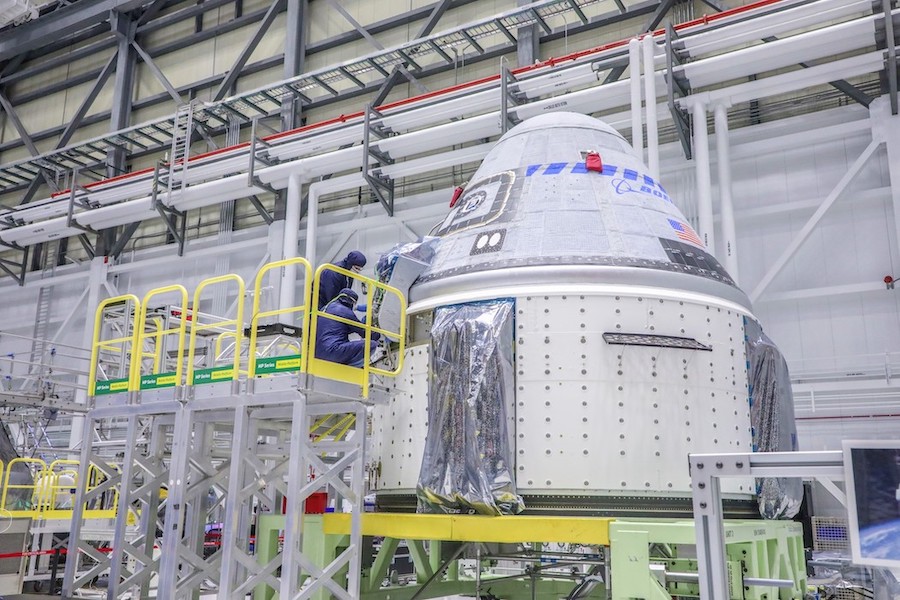
The U.S. Space Force has postponed a multi-spacecraft mission that was booked to fly on a United Launch Alliance Atlas 5 rocket in April, moving a redo of a test flight for Boeing’s Starliner crew capsule to the front of the line on ULA’s launch schedule.
ULA announced the delay in the Space Force’s USSF 12 mission in a brief statement shared on social media. The launch company, a 50-50 joint venture between Boeing and Lockheed Martin, said the delay was ordered at the request of the Space Force’s Space Systems Command.
“We will continue to work with SSC to determine USSF 12’s next launch opportunity,” ULA said.
The Starliner test flight, delayed from last August, was tentatively scheduled to launch from Cape Canaveral on May 20 before the delay in the USSF 12 mission. The USSF 12 postponement is not expected to allow the Starliner mission to move forward significantly.
The USSF 12 mission was set to launch in the first half of April with two Space Force payloads heading for geosynchronous orbit, a location more than 22,000 miles (nearly 36,000 kilometers) over the equator.
The Space Force’s Wide Field of View, or WFOV, surveillance satellite is the primary payload on the USSF 12 mission. The WFOV satellite is a testbed for a next-generation space-based sensor designed to detect rocket launches and provide early warning of a missile attack.
Built by Millennium Space Systems, the WFOV testbed satellite will host an optical staring instrument to detect the exhaust plumes from missile launches, demonstrating the wide-area sensor for future use in the military’s operational early warning systems.

Boeing’s Starliner team at Kennedy Space Center is readying the crew-rated spacecraft for a launch opportunity in May, a mission that now becomes the next flight on ULA’s Atlas 5 schedule.
The Starliner mission is a redo of an unpiloted test flight in December 2019 cut short by software problems. The software issues prevented the spacecraft from docking with the International Space Station, and the capsule safely landed in New Mexico after an abbreviated mission.
After several hardware and software changes, Boeing readied for second attempt at the Starliner’s Orbital Flight Test mission — designated OFT-2 — last August. The spacecraft was rolled to the launch pad at Cape Canaveral atop its Atlas 5 rocket, but tests revealed stuck valves in the Starliner propulsion system.
Boeing and NASA, which manages the Starliner commercial crew contract, agreed to remove the Starliner from the Atlas 5 rocket and postpone the mission to investigate the valve problem. Engineers believe the valve components likely corroded from the interaction of nitrogen tetroxide propellant with moisture that seeped into the thrusters on the spacecraft’s service module, then permeated a Teflon seal inside the valve itself.
Technicians removed the service module from the Starliner’s crew module in January for shipment to a test facility in New Mexico, where teams are performing tests to better understand the valve problem. The OFT-2 mission will fly with a new service module, one originally assigned to the first Starliner mission with astronauts.
Boeing said the Starliner team designed a new purging system to help prevent moisture from getting into the valves during the upcoming launch campaign while the spacecraft is in the factory and at ULA’s launch site.
If successful, the OFT-2 mission will pave the way for Starliner’s Crew Flight Test, which will carry a team of three NASA astronauts to the space station. That will ultimately lead to operational crew rotation flights on the Starliner spacecraft, akin to SpaceX’s Crew Dragon missions to the space station, giving NASA two U.S. vehicles capable of ferrying astronauts to and from the orbiting research complex.
Email the author.
Follow Stephen Clark on Twitter: @StephenClark1.
from Spaceflight Now https://ift.tt/MIujDkF
via World Space Info







0 comments:
Post a Comment